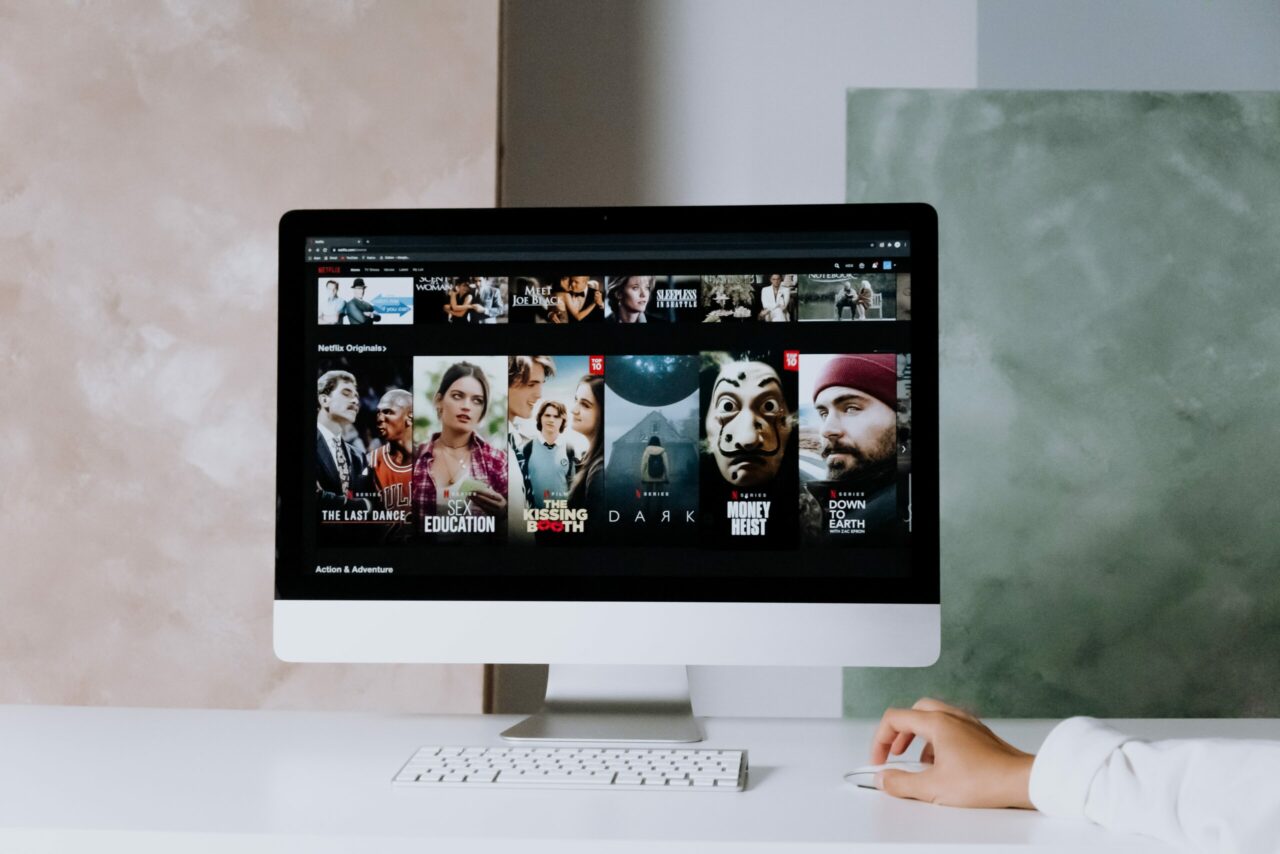

30. May 2023
Matthias Wagener
Welcome to part 4 of our blogpost series, in which we look at the topic of “streaming” in the context of sustainability! What impact do our extended evenings on the sofa have when we binge-watch series or enjoy a movie night?
Episode 01 of this series was already about the history of streaming. We learned that today streaming accounts for about 82% of the (internet) network traffic and that the sources of the resulting greenhouse gas emissions are generated through the necessary data centers, network infrastructure and of course the required end devices.
Perhaps there are ways to curb our streaming carbon footprint?
In episode 02, we looked at the role of data centers and their impact on climate and the environment. Episode 3 then looked at the network infrastructure that distributes data between data centers and brings it into our cozy homes. It became clear that it is a crux: for the ever-increasing demand for ever-faster networks with higher bandwidth, the infrastructure must be constantly adapted. Each new mobile network standard also produces a lot of waste and emissions in the process.
In the 4th episode, it’s our turn as end users: because the majority of CO2 emissions from streaming are caused by the end devices used!
So we look at how we can reduce the environmental impact of our laptops, smartphones and TVs, for example, by making more careful purchasing decisions.
So episode 4 is about us as users and streamers, because the majority of CO2 emissions from streaming are caused by the devices we use!
But can we reduce our environmental impact through our purchasing decisions and more mindful use of laptops, smartphones and TVs?

With a 47% share of greenhouse gas emissions from streaming, the required devices themselves, i.e. our smartphones, tablets, computers, and also TV sets, are the biggest emitters of digital greenhouse gases. The emissions occur both in the manufacturing process and through electricity consumption during operation and charging.
Let’s start with manufacturing: The components of all the digital devices we need for our streaming experience are unprecedentedly resource-intensive. A wide variety of metals, plastics, and rare earths are needed to manufacture them.
Among the end devices, televisions and flat screens still play an important role in streaming. According to information from the German Federal Environment Agency, modern flat screens are among the biggest power guzzlers in the household, along with refrigerators and freezers! Although a flat screen is generally more economical than an old tube TV of the same size, the motto “the bigger the better” has applied to many consumers for years.
However, few people consider the extent to which power consumption increases with the size of the screen. In addition, more valuable raw materials such as precious and special metals, rare earths and pollutants such as mercury or halogenated flame retardants are used in the production of modern flat screens.
An alternative for those who mainly watch movies and series at home is to purchase a projector – this can make far more sense than buying a large flat-screen TV. Although a projector can consume more electricity in operation than a television set, it has a much lower environmental impact in production than a television screen, where the image reaches the same diagonal. In the overall balance, a projector can therefore be more environmentally friendly than a flat screen.
However, one of the main problems when looking at end devices, is that users often give in to the urge to constantly upgrade to the latest device. Ever new picture qualities, sizes and device features are simply too tempting.
One of the reasons that we follow the advertising promises so uncritically is surely that most of us users don’t realize that the device itself causes almost half of the pollution coming from streaming.
And then there is the industry, the device manufacturers, who are not only constantly creating new desires: Older devices, which are in principle fully functional, are made more difficult to use or even completely unusable by changes to the operating systems. In addition, the cost of repairs is often almost as high as the price of a new device.
Speaking of old devices: Here, too, there is a lot of potential for avoiding emissions: The recycling rate of old end devices is still only at 20%. This is mainly due to the fact that it is still an extremely complicated, costly and uneconomical process to separate the raw materials used from one another and to recycle them in a meaningful way. In addition, the reuse of individual components and raw materials requires recycling methods that in some cases also have a negative impact on the environment.
At the same time, a large proportion of the materials currently used for end devices come from non-renewable sources. If we continue to use devices and replace them, often on a yearly basis, as we do now – according to estimates – in around 30-50 years there will no longer be enough minerals on earth to manufacture smartphones, tablets, computers and monitors. It is therefore all the more important that intensive research is also carried out into solutions here – but above all, manufacturers are called upon to find sustainable alternatives to previous raw materials. And: The appropriate legal framework is probably needed, and governments must ensure that resources are used more sparingly.
To once again look at the manufacturer and provider side: Operating systems and apps would need to have a lifespan of about 10 years to significantly curb resource consumption. Again, a legal framework that obliges manufacturers and providers to update and repair devices can be helpful.
Is there light at the end of this tunnel? In fact, the tech giant Apple, for example, has recently started to move on this issue (possibly also motivated by the millions in fines imposed in France in 2020, for example): The design of the iPhone has been revised and with the iPhone 14, Apple actually has a repairable version of its smartphone on the market.
However, the company itself has not made a big fuss about this innovation and it was not mentioned during the iPhone 14 keynote in September 2022. Be it to comply with the French “Law on Waste Control and Circular Economy”, which has stipulated a mandatory “reparability index” for a number of products since 2021. In addition to this, there is the premonition that other states will follow: in any case, the company has nevertheless taken an important step towards more durable products with this long overdue adjustment.
What can we as users do now? Sure, stream less, there are plenty of alternative activities. In practical terms, we can use our devices longer; the possibility of repairing them makes this easier. And passing on devices that are still usable, in the family or as a donation, can also play an important role on the path to more sustainability in the digital world.
In the spirit of the circular economy, we at VAST FORWARD have created an opportunity with our, for the time being internal, platform VAST CIRCLE to offer used equipment to our extended network and thus extend the life span of our professionally and privately used hardware.
The fact remains that we can all help to ensure that end devices have as long a life as possible. This can be achieved through careful handling of the devices and by repairing, passing them on and disposing of them properly at the end of their service life. At the same time, before buying a new device, we should always ask ourselves whether we really need it…
sources:
Apple | Frankreich verhängt Millionenstrafe wegen Drosselung älterer iPhones by spiegel.de
Nachhaltigkeit von Streaming by bitkom.org
Video-Streaming und CO2 | Die wichtigsten Fakten by bitkom.org
Digitales Lagerfeuer | Video-Streaming by bitkom.org
Blick auf das Streaming-Verhalten der Deutschen by marktforschung.de
Virtuelle Weihnachten | Streaming durch die Welt by videoaktiv.de
Frankenstream by arte.tv